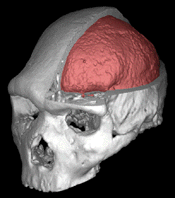


Skull with endocast Gerhard Weber; Institute of Human Biology/University of Vienna | The human brain is composed of soft neurological tissue that does not fossilize after death. However, the skull surrounding the brain, since it is hard, calcified bone, can become a fossil under the right conditions. Paleontologists and archaeologists may find these fossilized skulls at sites and use them to study what the brains of extinct hominids looked like and how they were organized. How can researchers study the brains that were not preserved? The brain often imprints the outline of structures in the bone of the skull, so a scientist can take the fossil skulls they do have and make a mold with latex, or endocast of the inside. This mold will have the inside of the fossil imprinted on its surface, enabling researchers to clearly see where blood vessels and structures such as Broca's area (see "The Language Connection") were located. |
| Ralph Holloway, a Professor of Anthropology at Columbia University, is one of the world's leading experts on the construction and analysis of endocasts. He explains the procedure for making an endocast in his 1978 article "Endocasts and Brain Evolution" summarized here. The researcher fills the cranium with consecutive layers of liquid or viscous latex until the latex is approximately 1 to 2 mm thick. Then the specimen is placed in an oven for 3 to 4 hours to cure it, after which the latex is extruded from the brain. This is accomplished by collapsing the latex, using baby powder to prevent sticking to the fossil, and slowly and carefully extruding it out of the fossil through the foramen magnum. After the latex is extruded, it will "pop back" into its form. The endocast of the specimen discussed in this sites next section, KNM-ER 1470, was prepared in this method by Ralph Holloway (Holloway 1978). |  Ralph Holloway |
According to Holloway (1978), problems with endocasts include the tendency of higher primates, including humans, to have a thick meninges covering the brain which can prevent the imprinting of the brain on the skull. Because of this, endocasts can only be used to support positive findings, not negative ones. For example, the presence of Broca's area on an endocast may support that that area existed in a species, but the lack of such an area in an endocast is not sufficient to support the species did not have that area. The second problem with brain research is the fragmentary nature of most fossil skulls. If a complete skull is lacking, a complete endocast cannot be made for study.
Endocasting is the only direct evidence that researchers can gather about brains. An indirect method of studying brain evolution is by comparative neuroanatomy. Scientists can compare the organization and appearance of brains from Pongoid and Hominoid species currently alive and then extrapolate how brains must have developed. Of course, both of these techniques can be used in conjuction for complete brain studies.

.